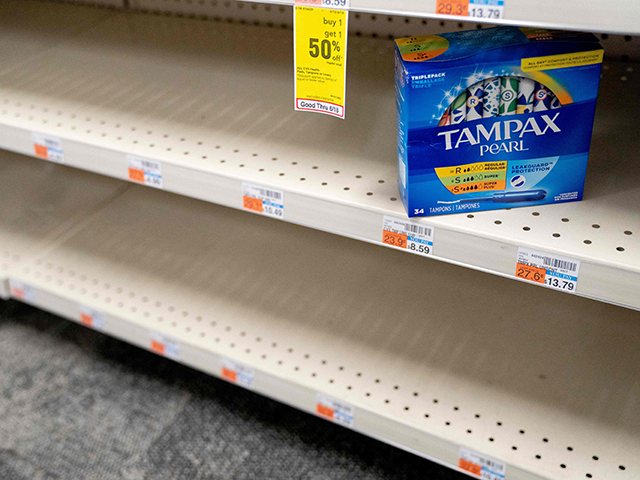Empty shelves spotted in the female hygiene sections in stores across the country are serving as the latest sign of a worsening supply chain crisis, as the country still reels from a baby formula shortage.
Last week, Procter & Gamble, which manufactures products such as Tampax tampons and Always pads, and comprises about half of the menstrual care market, admitted that consumers might currently be unable to find the products they typically purchase.
“The Tampax team is producing tampons 24/7 to meet the increased demand for our products,” it said in a statement, according to NBC News. “We are working with our retail partners to maximize availability, which has significantly increased over the last several months.”
While the manufacturer said the situation should be “temporary,” many Americans are expressing their frustrations across social media, with some deeming this President Biden’s latest “War on Women.” And the scarcity is more severe in three states, particularly: Alaska, Hawaii and West Virginia.

President Joe Biden speaks with Kristy Carr, Managing Director of Bubs Australia, during a virtual meeting with baby formula manufacturers at the Eisenhower Executive Office Building on June 01, 2022 in Washington, DC. (Kevin Dietsch/Getty Images)
According to Bloomberg, the in-stock rates in those three states “were below 90% in the week ended June 12, right around the mark where consumers start noticing empty shelves and can have trouble finding their preferred products, according to IRI.” The report continued:
Edgewell, the company behind brands like Playtex and o.b., cited disruptions caused by surges of the Covid-19 omicron variant as the cause for diminished inventory. It said it was operating manufacturing facilities around the clock to build back output.
…
Manufacturers have struggled to keep up with demand for a wide range of goods throughout the pandemic as they coped with raw material, labor, packaging and transportation challenges. An in-stock rate in the 90s is “pretty good” for any product category these days, said KK Davey, client engagement president at IRI. Some companies have rationalized their assortments since 2020, which could make it trickier to find a preferred brand or item.
The supply chain issue on menstrual products coincides with Americans grappling with 41-year high inflation, as it soared to 8.6 percent in May, defying expert predictions, as it was thought to go down to 8.2 percent.
What is more, the prices of basic goods have gone up far beyond the 8.6 inflation rate, as several political figures have pointed out in recent weeks. Sen. Rick Scott (R-FL), for example, cited the Producer Price Index (PPI) release from the Bureau of Labor Statistics (BLS) this week, explaining that the price of basic goods such as eggs have gone up 184.6 percent over the year. Menstrual products are no different, as the average price for tampons alone rose 9.8 percent.

COMMENTS
Please let us know if you're having issues with commenting.